I am so glad that some of you tried and liked the 36 hour sourdough baguette formula. I am still making it every week - it's our Friday "treat". Of course, I just can't help messing with a good thing, so I modify the original formula a little bit each time, some turned out really well, the following 3 are my recent favorites:
1) Pumpkin baguette - a.k.a. I don't care it's still nearly 90F out, it's FALL!

The idea came from this blog post, but I used pumpkin instead of butternut squash, toasted pumpkin seeds instead of sunflower seeds, and my basic 36 hour sourdough baguette formula.
AP Flour, 425g
pumpkin puree (I used canned), 165g
ice water, 223g
salt, 10g
starter (100%) 150g
pumpkin seeds, 50g, toasted and crushed a little
-Mix flour, pumpkin puree, ice water and autolyse for 12 hours.
-Mix in salt, starter, and seeds, then follow the basic 36 hour sourdough baguette formula here.
I find pumpkin puree generally makes bread moist but "sticky", which does make the crumb of these baguettes less open than the basic formula, but I think the brilliant golden color makes up for it, how very autumn-like.
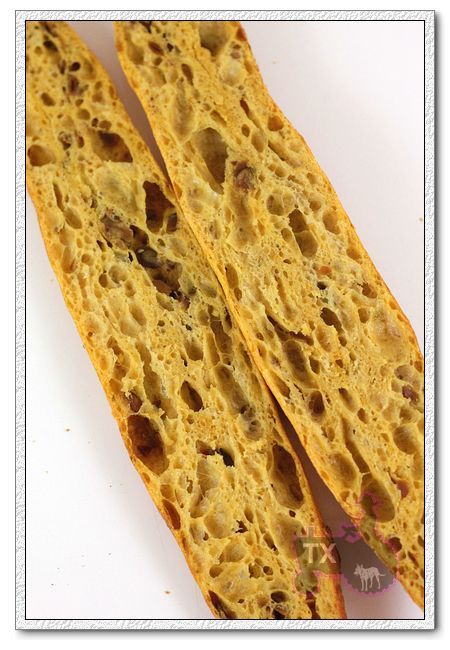
Pumpkin seeds are bigger than sunflower seeds, so I crushed them a little before adding into the dough, they still "blocked" some holes, but the crunch and flavor they add to the bread was great.

I counted 50% of the pumpkin puree weight is water, which turned out to be a good assumption. The dough felt similar to my usual 75% baguette dough, and I think I am getting better at scoring this wet baby.
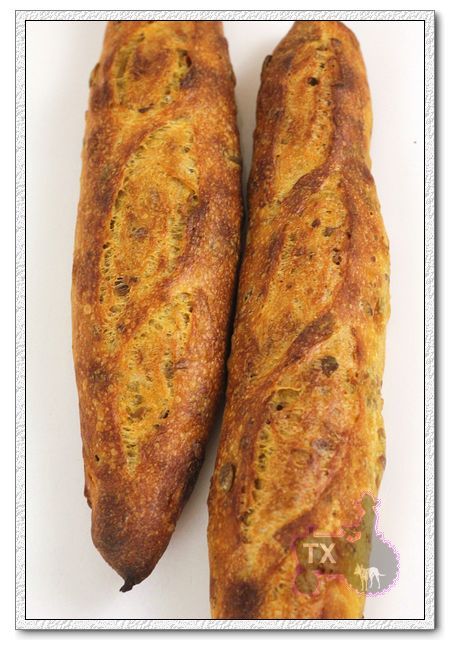
2) Wheatgerm baguette
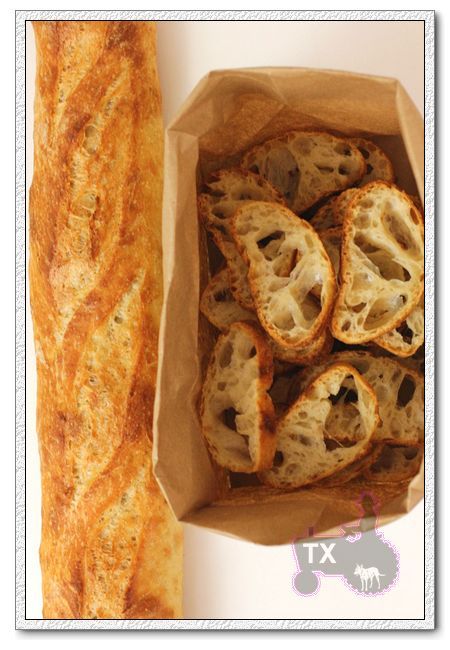
This is inspired by a formula we did at the SFBI baguette workshop. I love baking with wheatgerm, even my hands smell nice after touch the dough.I noticed at the workshop that wheatgerm tends to absorb extra water and make the dough a little dry, so I added extra water to compensate. The hydration ended up being 78%.
AP Flour, 425g
ice water, 315g
salt, 10g,
starter (100%), 150g
toasted wheat germ, 11g
- Mix water, flour and wheat germ, autolyse for 12 hours. Then follow the basic 36 hour sourdough baguette formula here.
The increased hydration worked, I got very open crumb AND fragrant wheat germ flavor.

If you really look, you can see the wheat germ grains on the wall of those big holes
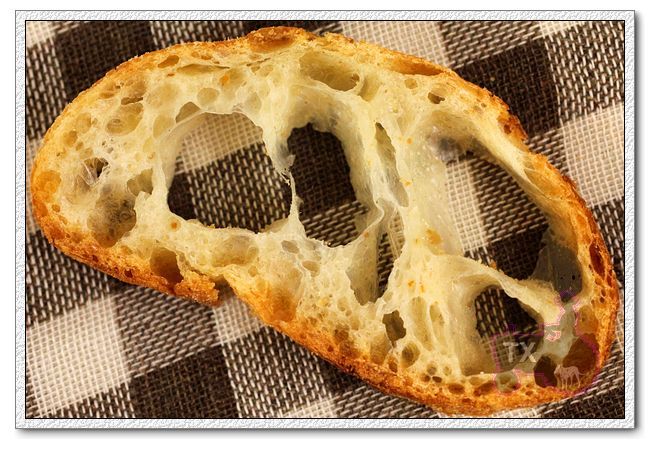
After making, and photographing so many baguettes, I was excited to find a new way to present it - in a paper bag!

I was in love with the flavor, and thought it ahs become my favorite variation, until I made the next one...

3) Rye starter baguette - MY FAVORITE SO FAR!
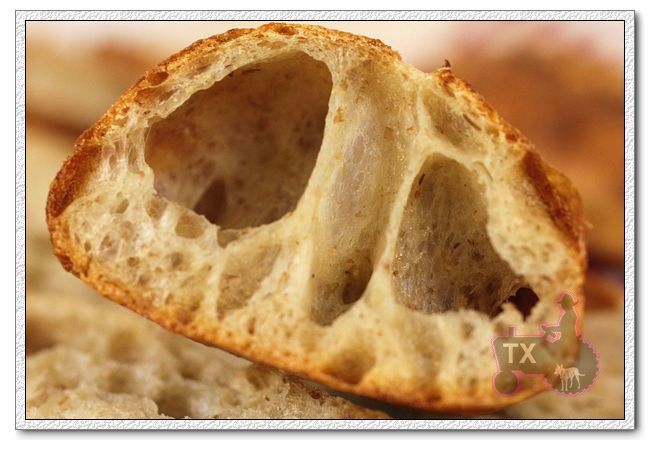
I have been wanting to add rye or other whole grain flour in the 36 hour baguette for a while now. In order to keep the open crumb, and the classic baguette mouth feel, I know I can't add too much. However, I do want to add enough to really taste the whole grain taste I love. This past weekend, I had a thought: instead of adding rye in the main dough, why don't I "add" it in the starter? Why not just use my rye starter instead of the white one? Since the formula has 30% of starter, which means the dough would have 15% of rye. The result is fantanstic, rye starter reallly adds noticable flavor even though rye ratio is low, at the same time, the crumb remains open, and crust is still thin and crisp.It's now my official favorite variation of 36 sourdough baguette, I am very happy that this experiment turned out so well!
Note that I did increase the hydration to 80%, mostly because I have been making breads from Tartine Bread Book, and its ww and semolina dough are both 80%+ hydration. Only that I forgot baguettes are a lot more tricky to shape than boules, oh, don't forget the minor details of scoring. I can now tell you first hand that scoring 80% wet baguettes is punishingly challenging. Crazy. Both I and the damn dough!:P
AP flour, 425g
ice water, 325g
rye starter (100%), 150g
salt, 10g
- follow the basic 36 hour sourdough baguette formula here.
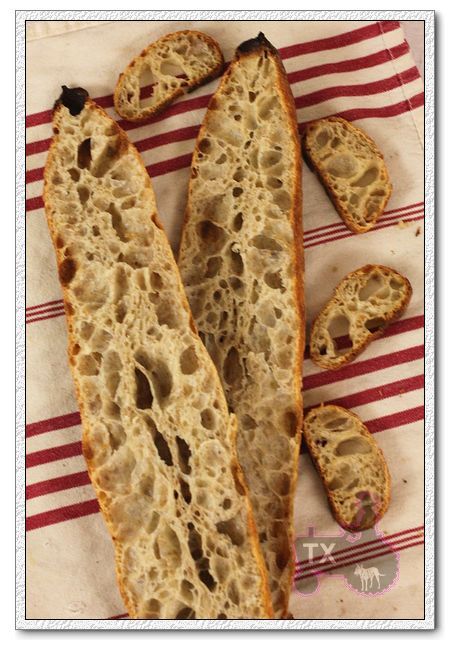
Such open crumb

One can get lost in these holes. Can't you just see the rye? YOu can taste it too! From the wall of the holes, yu can really see how moist the crumb is.

But the scoring left much to be desired, no matter, I know I will have plenty of opportunities to practice!
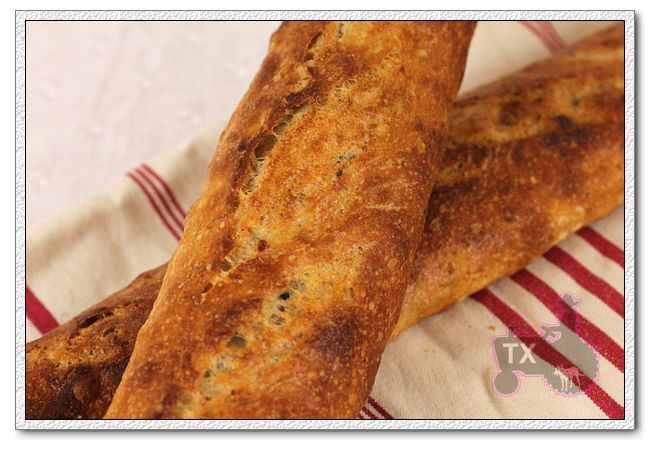
We usually eat these baguette as is, or simply with some butter or cheese, but I actually "loosely" followed a recipe from Tartine Bread Book and made a sandwich out of these rye baguettes. Tuna confit, roasted sweet pepper, fresh spinach, Yum!

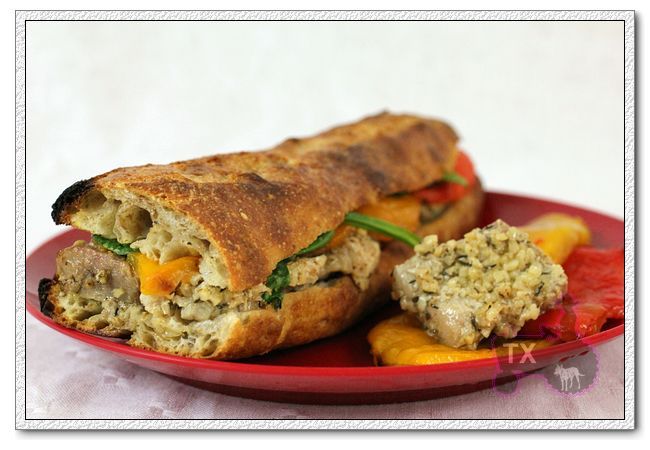
Submitting to Yeastspotting.
- txfarmer's Blog
- Log in or register to post comments
Iam speechless, txfarmer!!
I can't keep up with all that... got to admire your talent.
All i need is some time, some flour , a new oven (on its way btw), and i'll be baking some mini baguettes soon.
What oven do you have, txfarmer?
I have a very run-of-the-mill electric oven, nothing fancy, I can't even remember the brand.
Sandwiches too! Yummm, I do love a good sandwich, and on your lovely baguettes, what a perfect sandwich they make. Great photos!
Sylvia
Thanks for your kind words!
Dear txfarmer, Your baguettes and other 'bread projects' are simply amazing.
I love the way you've tried different flavors for baguettes.
Thanks for sharing the results of all of your hard work.
Regards, breadsong
Thanks!:)
Oh my goodness, txfarmer! When do you open your bakery shop? I have stopped making baguettes for a couple days :) Now I want to try this baguette for FALL!! It is FALL in NY already! Rye baguette's recipe is great , too! I have 100% rye sourdough culture.:)
Thank you for sharing your great recipes always!
Akiko
Good luck wiht experimenting, I don't think you can go wrong with any of these flavors. :)
Truly outstanding, txfarmer! I'm amazed that you manage to shape these doughs into baguettes at all, considering the ciabatta-like hydrations :) I read in your first post about these baguettes that you retard the dough in bulk, and let the dough come to room temperature before shaping. Would it be easier to work with if you shape the dough into baguettes without letting it come to room temperature first?
All three renditions are brilliant - I particularly like the different colours; the vibrant pumpkin puree baguette, the golden wheat germ one, and (arguably my favourite) the rustic, ruffled rye baguette.
When the dough is out of fridge, it's kinda stiff, not extensible enough to shape into baguette. By the time it relaxes, it's wet and sticky already. Plus I tried various fermentation schedules, this dough really does need a full bulk fermentation before being divided, otherwise the baguettes would be flat. In the mean time, the dough usually is not fully fermentated straight out of fridge. Basically I don't see a way to get away from handling the sticky wet dough - it's part of "baguette fun" right?:P
Words can't describe the perfection of those baguettes.
You are too kind. :)
where do you put the butter????
Cut horizontally like what I do in the sandwich picture, LOTS of butter can melt into those holes! Sort of like english muffins with lots of nooks and crannies to catch all the jam and butter.We are not big on butter with baguettes, but I do like to put dark chocolate on it, then heat, all those chocolate melt into the holes, hmmmmmm.
Hi txfarmer
More lovely breads! It's interesting that you, too, find that adding rye in the starter stage rather than when you're mixing the dough contributes a nice aspect to the flavour profile.
I've been using this technique with my favourite pain au levain for quite a while now, and posted about this a couple of weeks back (see here), but received no response on this rye starter aspect of the recipe. I'm sure this is not an original idea, but it is one that not so many people seem to draw on in their bread baking.
I'm glad that someone with a large following on TFL has now remarked on the benefits of adding rye in this way. Perhaps more folks will now try it with their recipes using 100% white starter. I find that 30% rye in the starter really does add a unique element to the flavour that is different from that yielded when rye is added at the dough mixing stage.
Cheers
Ross
might yield two different results. The more aged rye starter may impart a better rounded fruity-nutty flavour in my experience than a rye fed wheat starter. Although if a rye starter is not kept, it might be the next best thing and a quick solution if maintaining a rye starter is a problem.
I am thoroughly entertained by this blog and the photos are pure delight! So alluring and inspirational!
Mini
Hi Mini. I might not have made myself clear in my comments on rye starters...or maybe I'm not understanding you properly.
I keep a starter comprising 30% rye, 70% white flour. I don't build it just for a particular bread. It must be around 2 years old now.
But maybe you're referring to a 100% rye starter, when you write that it may improve the flavour still more and produce a better rounded fruity-nutty flavour? If so, I'll certainly have to try that, although I'll have to modify my pain au levain formula to take account of the quantity of rye in the final dough, and I'm not sure what effect that might have. This is my favourite bread! One way to find out, though...
Cheers
Ross
You normally feed and maintain a 100% hydration starter: 30% whole grain organic rye/70% organic unbleached AP flour. I thought maybe you had a 100% wheat starter and then before using it, added rye. Quite a few Loafers have rye starters and bake with them. It has been brought up in the past. Search in: Rye starter 2006 or change the year; plenty of hits. Most agree a little bit of rye in the starter helps a lot.
Ross, Mini is right that an 100% rye starter (which was what I used here) would impart more flavor to the bread than a starter fed with part rye and part white flour, but any rye in the starter would make a big difference. The idea of putting rye in the starter/levain and get extra flavor than just use rye in the final dough is not new, I have seen it in many books and posts here on TFL. The most recent one (hence the one I got my idea from this time) is Leader's Polish Cottage Rye (posted here), that's a 40% rye with all the rye in levain, and it tastes like a very high percent rye. Highly recommended.
I currently maintain 2 starters, 100% AP and 100% Rye, if I have to choose, I would keep the rye one, even though I love my white starter (that's my first born starter :P). The rye starter is simply more flavorful and versitile, and can be easily converted to all white in a few feedings if necessary.
I know exactly what you mean, txfarmer! I keep 3 different starters and sometimes end up leaving one in the fridge for weeks without taking it out for a feed and using it. I must have neglected my first-born a few days too long this time, because when I got it out it wouldn't reactivate. After 4 days, I had to pronounce it dead. Sad. BUT...
I kept feeding it and hallelujah! It is now resurrected. In effect, it's a new starter, but I'm seeing it as a reincarnation of my first-born because I prefer to think of it that way. A novel form of pain avoidance, I guess!
Thanks for the Leader link. Duly noted, and will definitely give that one a try.
Cheers
Ross
TxFarmer, only now i could indulge in reading your new entry about these amazing baguettes
The rye is calling my name really bad, I almost cannot stand the idea that it will be another FULL MONTH before I can try them.... come to think of it, by the time I get to it, you will be on your 8th variation on the theme.... ;-)
Thanks for sharing with us all your knowledge!
TxFarmer, what is your favorite length when shaping your gorgeous baguettes. Shorter and wider length/width for sandwiches? Your length for regular baguettes?
Sylvia
Unfortunately the length is dictated by my baking stone -- 16inch approx. I wish I could do "real" size baguettes, but I'll need a bigger oven and stone for that. Same length all the time since that's the only way they will fit on the stone.
I love the look of the crumb!! Fabulous.
-Elizabeth
I just baked seasonal German spelt pumpkin breads for sale - I like them a lot - but it would have never occurred to me to use pumpkin in a baguette. I'm quite intrigued by the idea.
I copied your baguette recipe but didn't get to try it out, yet. And now I have all these interesting variations to try out, too. More baking - more of "The Other Man", as my husband would say...
Thanks for sharing those recipes, txfarmer!
Karin
I was just logging on to tell you that own favourite variation so far is to substitute 10% w/w and 5% rye in my initial cold autolyse. I see that you've gone to the moon. What an inspiration! Thanks so much for all this posting.
:-Paul